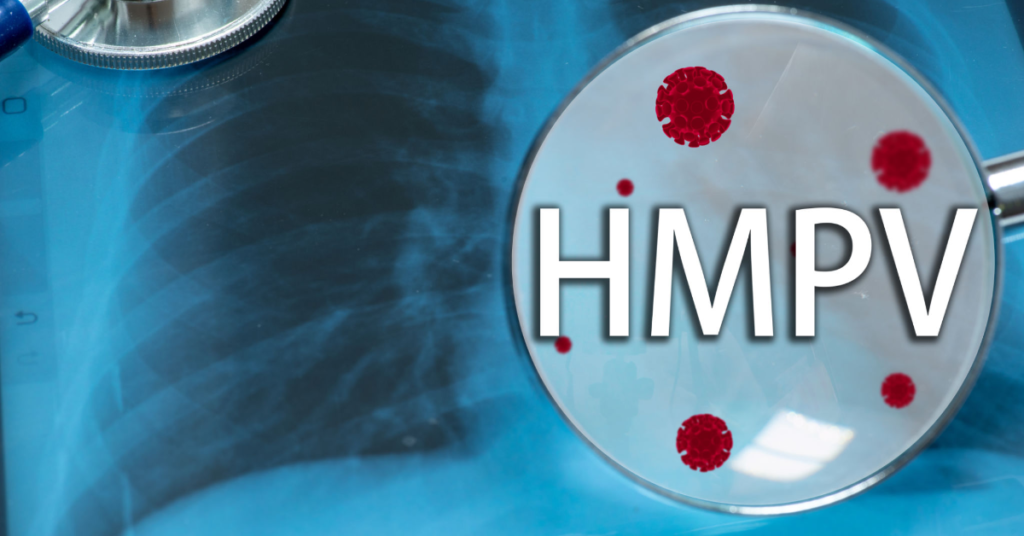A New Respiratory Threat in China?
Just five years after the world faced the devastating COVID-19 pandemic, another respiratory illness is making headlines in China. A surge in respiratory infections, suspected to be caused by rhinovirus and human metapneumovirus (HMPV), has overwhelmed hospitals in northern regions. With symptoms ranging from mild colds to severe breathing difficulties, understanding the differences between rhinovirus vs HMPV is crucial.
These two viruses are often mistaken for one another, but their impact on health can vary significantly. This article will explore rhinovirus vs HMPV, their symptoms, transmission, and prevention, to help you stay informed and proactive.
What is Rhinovirus? Comparing It to HMPV

Rhinovirus is the leading cause of the common cold, accounting for more than half of all cold-related illnesses. It’s a highly contagious virus, especially during colder months, and while it’s usually mild, it can pose risks for certain people.
Symptoms of Rhinovirus and How It Differs from HMPV
Common symptoms include:
- Runny or congested nose
- Sore throat
- Cough
- Mild fever
For people with respiratory conditions like asthma or chronic obstructive pulmonary disease (COPD), rhinovirus can trigger serious complications, including difficulty breathing. Therefore, it’s essential to monitor symptoms carefully if you belong to these groups.
How Rhinovirus Spreads Compared to HMPV
- Through the air: Respiratory droplets from coughing or sneezing.
- By touch: Contact with contaminated surfaces or direct physical contact.
In northern China, heavy rains and colder weather are likely fueling the rapid transmission of rhinovirus. Moreover, spending more time indoors during winter increases the chances of the virus spreading.
To learn how to manage colds effectively, check out the CDC’s Cold Prevention Tips offer valuable insights.
What is HMPV? The Key Differences Between Rhinovirus vs HMPV

Human metapneumovirus (HMPV) is another respiratory virus, though it’s less well-known than rhinovirus. First identified in 2001, it primarily affects the lower respiratory tract and is more likely to cause severe illness in certain groups, such as people over 65, young children, and those with weakened immune systems.
Symptoms of HMPV and How They Compare to Rhinovirus
HMPV symptoms are often more severe than those of rhinovirus and include:
- Persistent coughing
- Wheezing or shortness of breath
- Fever
- Fatigue
Because these symptoms can overlap with other illnesses, it’s crucial to seek medical advice if symptoms worsen.
How HMPV Spreads and Its Similarities to Rhinovirus
Much like rhinovirus, HMPV spreads through respiratory droplets, contaminated surfaces, and close personal contact. Additionally, its outbreaks often coincide with late winter and spring.
HMPV in China’s Current Outbreak
In northern China, many people are reporting difficulty breathing—symptoms that align with HMPV infections. Hospitals are experiencing overcrowding, and public health officials are working to confirm the virus’s role in this ongoing crisis.
For more insight into respiratory virus prevention, explore the WHO’s advice on respiratory health.
Rhinovirus vs HMPV: Key Similarities and Differences
Although both viruses are common causes of respiratory infections, they differ significantly in their impact.
| Aspect | Rhinovirus | HMPV |
|---|---|---|
| Primary Symptoms | Runny nose, sore throat | Cough, wheezing, fatigue |
| Severity | Mild for most people | Severe in young children and people over 65 |
| Common Season | Winter and rainy months | Late winter and spring |
| Affected Populations | All age groups | People with weaker immune systems |
Why Rhinovirus vs HMPV Matters Right Now
Understanding rhinovirus vs HMPV is essential, especially when hospitals are already overwhelmed. While rhinovirus is widespread and typically mild, HMPV demands more attention due to its potentially severe effects on respiratory health.
China’s Current Battle: How Rhinovirus and HMPV Are Affecting Public Health

What’s Happening Now?
China’s winter season is typically associated with respiratory illnesses, but this year has seen an unusual surge. According to Reuters, hospitals in northern regions are crowded with people seeking treatment for severe breathing issues. Many cases are believed to be linked to rhinovirus and HMPV, though authorities are conducting further investigations.
Public Health Response to Rhinovirus and HMPV
China’s Centers for Disease Control and Prevention (CDC) is monitoring the situation closely. Public health officials are urging people to take precautions such as wearing masks and avoiding crowded places during the outbreak.
Comparisons to COVID-19: How Rhinovirus vs HMPV Differs
While this outbreak is not as severe as COVID-19, the similarities in symptoms and timing have drawn attention. Experts emphasize that increased awareness and preventive measures can help curb the spread.
For strategies to protect yourself during outbreaks, read our article on Managing Seasonal Outbreaks.
What COVID-19 Taught Us About Rhinovirus and HMPV
The COVID-19 pandemic reshaped how we approach infectious diseases. Here’s what we can apply to the current situation:
- Preparedness Saves Lives: Early identification and containment are key.
- The Role of Individuals: Staying informed and practicing good hygiene makes a significant difference.
- Global Cooperation is Essential: Outbreaks in one region can affect the entire world.
By keeping these lessons in mind, we can address respiratory viruses like rhinovirus and HMPV more effectively.
Protecting Yourself from Rhinovirus and HMPV

You can reduce your risk of catching or spreading respiratory viruses by following these simple steps:
1. Practice Good Hygiene for Both Rhinovirus and HMPV
- Wash your hands frequently with soap and water.
- Avoid touching your face, especially your nose and mouth.
- Disinfect commonly touched surfaces regularly.
2. Strengthen Your Immune System to Fight Rhinovirus and HMPV
- Eat a balanced diet with plenty of fruits and vegetables.
- Stay hydrated and get enough sleep.
- Exercise regularly to boost your overall health.
3. Protect Vulnerable Groups from Rhinovirus and HMPV
- If you live with or care for young children, people over 65, or those with weakened immune systems, take extra precautions like wearing a mask and limiting exposure to crowded areas.
4. Seek Medical Attention for Severe Symptoms
If you experience shortness of breath, persistent coughing, or high fever, consult a healthcare provider immediately. Early treatment can prevent complications.
Looking for more prevention tips? Check out our guide on Boosting Your Immune System Naturally.
Stay Informed, Stay Proactive
Understanding the differences between rhinovirus vs HMPV is crucial, especially in light of the current respiratory illness surge in China. While rhinovirus is common and generally mild, HMPV can lead to serious complications in certain populations.
As we navigate the winter season, let’s remember the importance of awareness, good hygiene, and proactive health measures. By working together and staying informed, we can reduce the impact of these respiratory viruses and keep ourselves and our communities safe.



